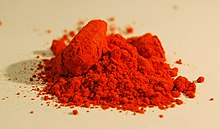This is the current revision of this page, as edited by 96.252.13.92 (talk) at 15:10, 6 June 2024. The present address (URL) is a permanent link to this version.
Revision as of 15:10, 6 June 2024 by 96.252.13.92 (talk)(diff) ← Previous revision | Latest revision (diff) | Newer revision → (diff)
| |

| |

| |
| Names | |
|---|---|
| Preferred IUPAC name Sodium 4-{diazenyl}benzene-1-sulfonate | |
| Other names Sodium 4-benzenesulfonate | |
| Identifiers | |
| CAS Number | |
| 3D model (JSmol) | |
| ChemSpider | |
| ECHA InfoCard | 100.008.115 |
| EC Number |
|
| PubChem CID | |
| UNII | |
| UN number | 3143 |
| CompTox Dashboard (EPA) | |
InChI
| |
SMILES
| |
| Properties | |
| Chemical formula | C14H14N3NaO3S |
| Molar mass | 327.33 g·mol |
| Appearance | Orange or yellow solid |
| Density | 1.28 g/cm |
| Melting point | > 300 °C (572 °F; 573 K) (not precisely defined) |
| Boiling point | Decomposes |
| Solubility in water | 5 g/L (20 °C) |
| Solubility in diethyl ether | Insoluble |
| Hazards | |
| Occupational safety and health (OHS/OSH): | |
| Main hazards | Toxic (T) |
| GHS labelling: | |
| Pictograms | 
|
| Signal word | Danger |
| Hazard statements | H301 |
| Precautionary statements | P308, P310 |
| NFPA 704 (fire diamond) |
 |
| Lethal dose or concentration (LD, LC): | |
| LD50 (median dose) | 60 mg/kg (rat, oral) |
| Except where otherwise noted, data are given for materials in their standard state (at 25 °C , 100 kPa).
| |
Methyl orange is a pH indicator frequently used in titration because of its clear and distinct color variance at different pH values. Methyl orange shows red color in acidic medium and yellow color in basic medium. Because it changes color at the pKa of a mid strength acid, it is usually used in titration of strong acids in weak bases that reach the equivalence point at a pH of 3.1-4.4. Unlike a universal indicator, methyl orange does not have a full spectrum of color change, but it has a sharp end point. In a solution becoming less acidic, methyl orange changes from red to orange and, finally, to yellow—with the reverse process occurring in a solution of increasing acidity.
Indicator colors

In a solution that decreases in acidity, methyl orange moves from the color red to orange and finally to yellow with the opposite occurring for a solution increasing in acidity. This color change from yellow to red occurs because the protons in the acidic solution react with the N=N bond of the molecule, protonating one of them and changing the visible light absorption of the molecule to reflect more red light than orange/yellow.
| Methyl orange (pH indicator) | ||
| below pH 3.1 | above pH 4.4 | |
| 3.1 | ⇌ | 4.4 |
In an acid, it is reddish and in alkali, it is yellow. Methyl orange has a pKa of 3.47 in water at 25 °C (77 °F).
Other indicators
Main article: pH indicator| Methyl orange in xylene cyanol solution (pH indicator) | ||
| below pH 3.2 | above pH 4.2 | |
| 3.2 | ⇌ | 4.2 |
Modified (or screened) methyl orange, an indicator consisting of a solution of methyl orange and xylene cyanol, changes from grey-violet to green as the solution becomes more basic.
Safety
Methyl orange has mutagenic properties. When methyl orange is put under oxidative stress, one of the double-bonded nitrogen atoms that connects the aromatic rings gets radicalized and can further break down into reactive oxygen species or anilines, which are carcinogenic and can mutate DNA. Various bacteria and enzymes can also cause this breakdown to occur.
Synthesis
Methyl orange is an azobenzene derivative that can be formed from dimethylaniline and sulfanilic acid, first through a diazonium salt formation with the sulfanilic acid, followed by a nucleophilic attack from the dimethylaniline and rearomatization.
UV-vis spectrum
The absorption of methyl orange on the UV-vis spectrum is between 350-550 nm, with its peak at 464 nm. This is in the green-purple visible light range and explains why methyl orange is, in fact, orange.
See also
References
- ^ Haynes, William M., ed. (2016). CRC Handbook of Chemistry and Physics (97th ed.). CRC Press. p. 3.384. ISBN 9781498754293.
- ^ MSDS Archived 2014-05-12 at the Wayback Machine from ScienceLab.com, Inc. Retrieved 2011-09-24
- Clark, J. "Acid Base Indicators". ChemGuide. Retrieved November 12, 2022.
- Sandberg, Richard G.; Henderson, Gary H.; White, Robert D.; Eyring, Edward M. (1972). "Kinetics of acid dissociation-ion recombination of aqueous methyl orange". The Journal of Physical Chemistry. 76 (26): 4023–4025. doi:10.1021/j100670a024.
- Wojnárovits, L; Takács, E (2008). "Irradiation treatment of azo dye containing wastewater: An overview". Radiat. Phys. Chem. 77 (3): 225–244. Bibcode:2008RaPC...77..225W. doi:10.1016/j.radphyschem.2007.05.003.
- Liu, Ting-ting; Shi, Chun-ling (January 2005). "Improvement of Methyl Orange Preparation". Guangzhou Chamical Industry. 43 (1): 76–77.
- Ayed, Lamia; Khelifi, Eltaief; Jannet, Hichem Ben; Miladi, Hanene; Cheref, Abdelkarim; Achour, Sami; Bakhrouf, Amina (2010-11-15). "Response surface methodology for decolorization of azo dye Methyl Orange by bacterial consortium: Produced enzymes and metabolites characterization". Chemical Engineering Journal. 165 (1): 200–208. doi:10.1016/j.cej.2010.09.018. ISSN 1385-8947.